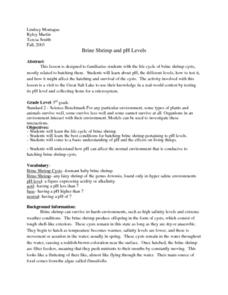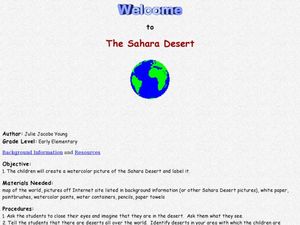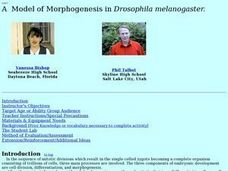Curated OER
Brine Shrimp And Ph Levels
Third graders investigate the different ph levels found in water that is tested using simple measurements. The water samples are taken from a local body of water. The ph levels are used to help indicate areas where shrimp can thrive in...
Curated OER
Manifest Destiny
In this United States history instructional activity, students utilize a word bank of 10 terms or phrases to answer 10 fill in the blank questions pertaining to Manifest Destiny. A short answer question is included as well.
Curated OER
Welcome to the Sahara Desert
Students explore their artistic skills. In this Sahara Desert instructional activity, students use the Internet to research the Sahara and paint a watercolor picture depicting the desert.
Curated OER
Cricket Wars
Students investigate crickets in their habitat. In this insect lesson, students create a cricket habitat by using a glass jar with grass clippings and cloth. Students observe how crickets interact with each other and their eating habits.
Curated OER
Utah's Children's Health Insurance Program (chip): How Well Are We Doing?
Students analyze Utah's CHIP program. They compares it to other states in terms of benefits and customer satisfaction. They examine how rules and regulations at the federal level shape state-level program operations. They research and...
Curated OER
Introduction To Brine Shrimp
Fourth graders engage in a variety of activities in order to find information about the brine shrimp. The lesson includes background information for the teacher to deliver instruction. They make observations of the shrimp in different...
Curated OER
An Introduction to Brine Shrimp
Second graders engage in a lesson that seeks to discover information about Brine Shrimp. They conduct research using a variety of print and electronic resources. Students study the type of environment the shrimp need and read about the...
Curated OER
Have I Got A Story For You - Folklore of Utah
Fourth graders identify the clues that folklore provides about Utah's past. They create a piece of folklore for a place or event in or near the community. They see that the legends and traditions we pass to one another are also sources...
Curated OER
Oolitic Sand: An Introduction
Fourth graders investigate the characteristics of different types of sand. They compare and contrast the types of sand by making observations with a dissecting microscope. Then students draw what is seen and include shape, color, and...
Curated OER
Salinity Of Soil
Fourth graders investigate the contents of various types of soil to determine the differences in salinity levels. They conduct an experiment of observing the plants in the different soils. Students then determine survival rates by...
Curated OER
Route Map Lesson Plan
Students read and make a route map by following step by step directions. They identify and make legends.
Curated OER
Hatching Brine Shrimp
Third graders investigate the environment that is considered favorable for brine shrimp hatching. The salinity level is of particular interest in the observations because the optimum level is needed for survival. They make daily...
Curated OER
Heritage: What if the Mormons had not come to Utah?
Fourth graders use critical thinking, evaluation, and geography skills to find alternative locations that Brigham Young could have taken the Mormons to settle. They present their findings to Brigham Young and the class with a short...
Curated OER
Dig Magazine Archeology Quiz #49
For this Dig Magazine archeology worksheet, students complete a 4 question quiz on "kid power" from the February 2006 issue. Answers and links to additional resources are included.
Curated OER
Heritage: Famous People of the West
Fourth graders examine two famous people, Brigham Young and Jim Bridger, who made an impact on the westward expansion, and create cartoon strip using the information.
Curated OER
UMNH: The Fremont People
Third graders explore the Fremont people and then make their own Fremont-Style pottery.
Curated OER
Social Studies: The Fremont People
Learners examine the culture of the Fremont people prior to creating their own copies of their pottery. With teacher-supplied clay, students follow instruction sheets to make their own replicas based on the Fremont pottery designs.
Curated OER
Seeing/Reading Photographs Lesson Plan: An Interactive History Discussion
Students analyze and read historic photographs. In this historic photographs lesson, students explore history and writing by looking at photographs. Students discuss the photographs and produce a written record of the historical photograph.
Curated OER
The Ethics School: Session 5
Middle schoolers discuss the need for a Code of Conduct when they are using any type of technology in their workplace. In groups, they examine the various descriptions of areas to focus on to have a complete professional code of ethics....
Curated OER
The Caspian Sea
In this comprehension and geography worksheet, students read an article about the Caspian Sea, identifying where it is located and what countries surround it. Then they describe three parts of the sea, what are tributaries, and how many...
Curated OER
Pond Life
Environmental explorers create an experiment related to ponds and then present their finding to the class. This resource is extremely open-ended. It needs more concrete objectives and procedures for meeting them.
Curated OER
The Salt Water Connection
Students investigate the various factors that influence the Pacific Ocean and Monterey Bay, California. They watch a video about Monterey Bay and take notes, and conduct research and write a report about a specific organism living in...
Curated OER
'Water, Water Everywhere...'
Fourth graders explore how the Utah pioneers used irrigation to make the desert 'blossom as a rose'. They use geographical tools to analyze political and physical features of Utah, the United States, China, and Asia.
Curated OER
A Model of Morphogenesis in Drosophila Melanogaster
Students investigate the following scientific terms and ideas: rates of diffusion, the role of morphogens in the development of larva, the chemical dynamics of a cell, and the significance of embryo polarity during development.

























